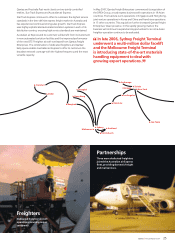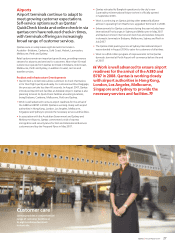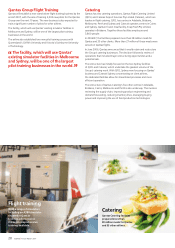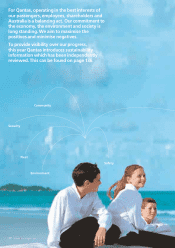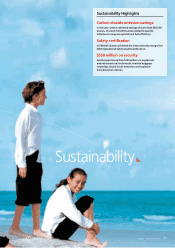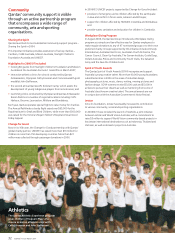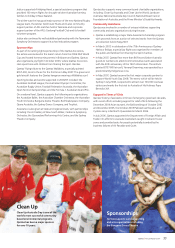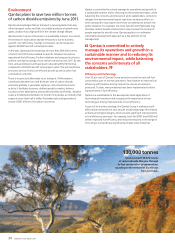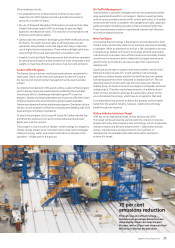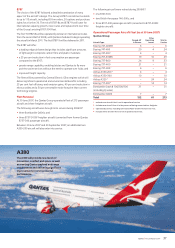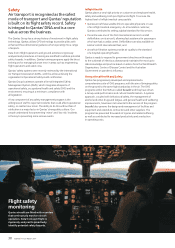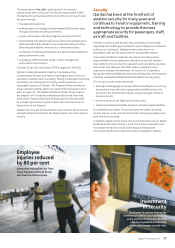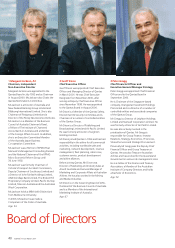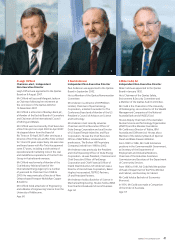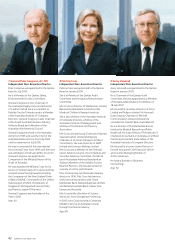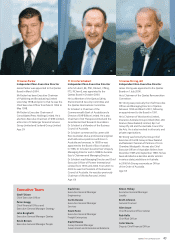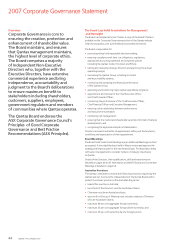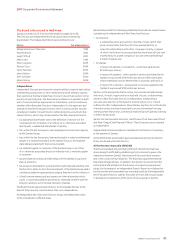Qantas 2007 Annual Report Download - page 37
Download and view the complete annual report
Please find page 37 of the 2007 Qantas annual report below. You can navigate through the pages in the report by either clicking on the pages listed below, or by using the keyword search tool below to find specific information within the annual report.
70 per cent
emissions reduction
Through new aircraft technology
emissions per passenger kilometre have
decreased by 70 per cent over the past
40 years, with a 20 per cent increase in fuel
efficiency in the last decade alone.
35Qantas |Annual Report 2007
Other initiatives include:
•the establishment of an Environment and Fuel Conservation
department in 2005 (Qantas has had a specialist environment
group for a number of years);
•the use of Required Navigation Performance procedures that utilise
Global Positioning System (GPS) technology to optimise flight
approach and departure tracks. This reduces fuel consumption and
emissions and improves safety;
•Qantas was instrumental in developing User Preferred Routes across
the Pacific. The airline has been able to efficiently plan aircraft
operations along flexible routes that adjust each day to make best
use of higher-level wind patterns. These enhanced flight paths have
reduced flight times and associated fuel consumption; and
•Variable Cost Index Flight Planning ensures that aircraft are operated
at optimal speed, based on daily variations in wind, temperature and
weight, to maximise efficiency and reduce fuel burn and emissions.
Carbon Offset Program
The Qantas Group has been working towards greener operations for
some years. More can be done and a program to take the Group to
the next level of environmental management will be launched later
in 2007.
An important component of this launch will be a carbon offset program
which has been rigorously assessed and accredited by the Australian
Greenhouse Office’s Greenhouse Friendly Program™. Under the
program, Qantas and Jetstar passengers can choose to offset their share
of flight emissions with all contributions going towards Australian
Government approved carbon abatement programs. Qantas and Jetstar
will also use the program to offset the emissions generated by staff work
travel and ground transport operations.
To launch the program, the Group will fund a Fly Carbon Neutral Day
and offset the emissions from all of its international and domestic
flights over a 24 hour period.
This program is only one part of Qantas’ overall strategy to mitigate its
climate change impact which includes further conservation strategies
relating to energy, water, and waste minimisation in all areas of the
operation – inflight and on the ground.
Air Traffic Management
Improvements in air traffic management have the potential to deliver
large operational benefits to air transport. Qantas is working closely
with air service providers and air traffic control authorities, in Australia
and around the world, to establish new navigational routes, approach
paths and airborne holding procedures that will reduce flight times.
These improvements promise to significantly improve fuel efficiency
and reduce related emissions.
New Fuel Types
It is essential that technology is developed to provide alternative fuels
that are both commercially viable for air transport and environmentally
sustainable. While an alternative to jet fuel is still considered to be over
a decade away, Qantas continues to encourage airframe and engine
manufacturers to produce more efficient and environmentally friendly
aircraft over the long term and to lobby the fuel supply industry and
governments to provide the necessary support for research and
development.
Significant issues exist for aviation with both synthetic and bio fuels.
Manufacturing processes for current synthetic fuels emit large
quantities of carbon dioxide and the fuel itself has less than optimal
lubricating properties when compared to standard jet fuel. This can
adversely impact fuel lines and seals. Bio fuels have poor thermal
stability (they can freeze at around zero degrees centigrade) and lower
energy output. They also require large amounts of arable land and
water for their production and have the potential to impact on the
price of standard food crops, which have to compete for that land.
Such alternative fuels promise to deliver the greatest environmental
benefits to the aviation industry, however, significant technology
breakthroughs are required.
Airline Industry Emissions Target
IATA has set an aspirational target of zero emissions by 2050.
This target will be achieved by working with the industry to improve
airspace efficiency and employing new technology, which incorporates
onboard, engine and airframe advancement. Collaboration among
airlines, manufacturers and government to focus efforts on
development of sustainable alternative fuels will be essential to
achieve this target.


